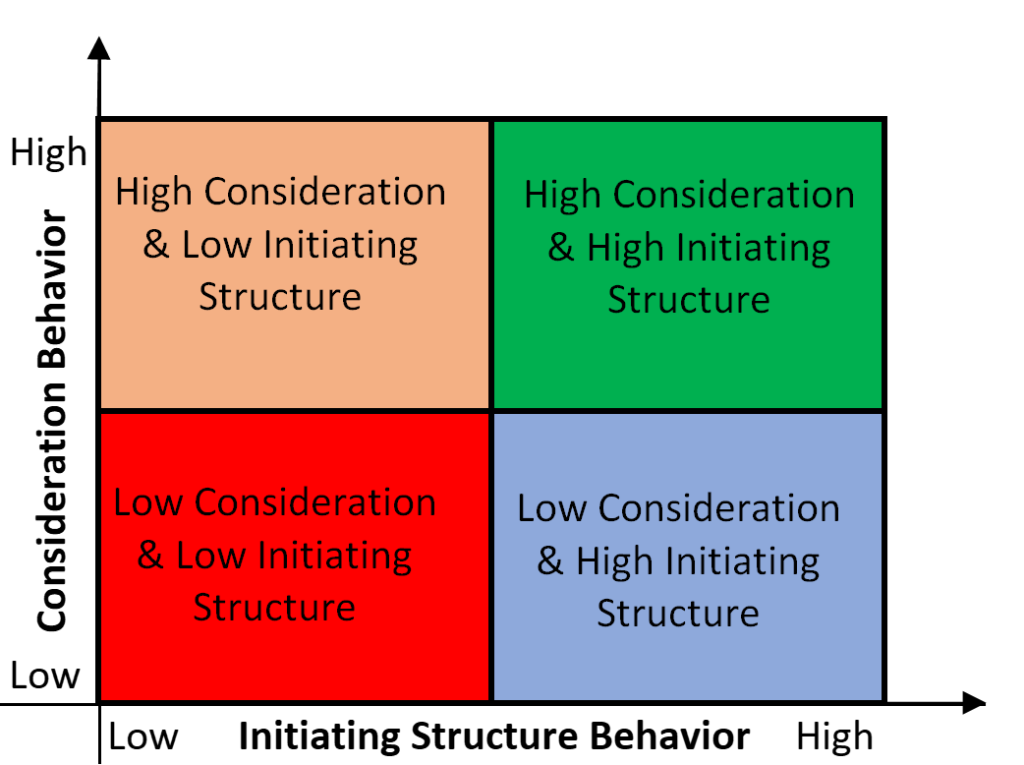As a senior leader in business, I find most leadership theories fascinating, including old ones such as the Michigan Leadership Studies, a leadership research program aimed at determining leadership behaviors connected to high-performing groups. The Michigan Leadership Studies primarily involved interviews with high and low effectiveness examples of leaders and followers. This article will tell you more about the Michigan leadership studies and their conclusions, which some hold to this day. We start with a brief overview answer.
What is the Michigan Leadership Studies?
The Michigan Leadership studies were undertaken in the 1950s and involved surveys and interviews of supervisors in high or low production teams. The Michigan leadership studies concluded that leaders could be job-oriented, with a focus on production, or employee-oriented, with a focus on people.
The Michigan Leadership Studies
The Michigan University leadership studies came in the 1950s, just after the Ohio State Leadership Studies of the 1940s, and was led by Rensis Likert, a social psychologist. (Michigan and Ohio studies are amongst the ten leadership theories in our Leadership Origins E-book.) The program was funded by the Office of Naval Research, which amended the purpose of the funding was to determine “principles which contributed both to the productivity of the group and to the satisfaction that the group members derive from their participation”.[i] Surveys and interviews within the studies were aimed at finding out the behaviors common for the most effective leaders, thus unlocking the key to becoming a high-performing leader. The approach was a strictly behavioral leadership theory, unlike many of the current studies that were focused on the trait theory of leadership. The Michigan studies purely had the behaviors of leaders in focus, discounting the situation they were in or whether they varied their behavior over time.
The Michigan University Leadership studies found two categories of leadership behaviors: job-oriented and employee-oriented leadership behaviors. As with most behavioral leadership approaches, the Michigan leadership studies suggest that these two leadership behaviors are mutually exclusive, and a single leader cannot display both types of behaviors. Thus, leaders are either employee-oriented or job-oriented (also referred to as production-oriented in some sources), which is shown depicted below. Just as in the case of transformational and transactional leadership, later studies concluded that the two leadership styles did not have to be mutually exclusive, rendering the Michigan Studies continuum graph less viable. (You can read about transformation/transactional leadership at our main site on leadership styles.)

The two leadership styles of the Michigan Leadership Studies
We can, of course, discuss whether the two types of behaviors identified in the Michigan Unversity Leadership studies can be considered as actual leadership styles or not. But let us not get hung up on definitions. Let us instead jump into the two behavioral leadership styles of the Michigan Leadership studies, which are job-oriented leadership behavior and employee-oriented leadership behavior.
The Michigan Leadership Studies emphasized that both employee-oriented and job-oriented leaders could be good and deliver excellent performance. The Michigan studies also added a team element to their research, which was a bit of a novelty in leadership research at the time.
The Job-oriented behavioral leadership style
As the name indicates, the job-oriented leadership style is all about getting tasks and activities done to secure production and other output. A job-oriented leader sets performance targets and focuses on the actual work, including processes, instructions, etc., rather than the employees and their development. Work is always at the focal point, and time pressure, profit pressure, or production pressure needs to be handled in a strict way, where the job-oriented leader pushes the employees to perform better and faster. To accomplish this, close monitoring, management-by-exception, micromanagement, directive behaviors, and viewing the employees as mere tools are common. Many of these concepts can be found in Scientific Management (Taylorism).
There are strong similarities between the job-oriented leadership style and many other task-oriented leadership styles, such as:
- The telling leadership style of the Situational Leadership model
- The commanding and pacesetting leadership styles of the Goleman leadership styles
- The transactional leadership style of the Full Range Leadership Development framework
- The autocratic leadership style of the Kurt Lewin leadership styles
You can read about all those frameworks and more than 25 other leadership styles in our leadership styles portal, which seems to be the biggest one available online right now.
The Michigan University leadership studies concluded that the job-oriented leadership style indeed led to strong productivity and performance. Still, it also brought high employee turnover, absenteeism, lower employee engagement, and little trust. Typical side effects of too much focus on tasks while sacrificing the soft parameters of employee development. (If you have problems with extreme task-focus in your leadership, consider my Pacesetting Leadership Blueprint to lessen the stress impact on the team.)
The Employee-oriented behavioral leadership style
The employee-oriented leadership style of the Michigan Leadership Studies is the complete opposite of the job-oriented leadership style. An employee-oriented leader focuses on the people, their needs, development, and opinions. The social aspects of work get much more attention, including positive feedback, social relationships, individuality, participation, employee motivation, interaction, support, etc.
The employee-oriented leadership style is comparable to many other leadership styles, such as:
- The participative leadership style of the Situational Leadership Model
- The democratic, affiliative, and coaching leadership styles in the Goleman leadership framework
- The transformational leadership style of the Full Range Leadership model
You can read about all these leadership styles in our portal as well or get our Leadership Origins E-book which contains the Situational Leadership Model and several other important leadership theories.
The employee-oriented leadership style also results in setting performance targets. However, rather than dictating them to the employees, the employees’ ideas, creativity, and opinions are used as input for target setting. The Michigan Leadership Studies concluded that employee-oriented leader behavior led to higher group performance.
Conclusions of the Michigan Leadership Studies
Besides the two leadership styles mentioned above, the Michigan Studies also concluded the following:
- Supervisors of high-producing teams were judged as being more employee-oriented, whereas low-producing team supervisors were more job-oriented.
- The employee-oriented leaders spent more time in leadership and management activities and less time performing the actual tasks together with the other employees
- Followers of employee-oriented leaders had stronger personal relationships with their leaders, who were more interested in individuals and more forgiving when it came to errors and mistakes
- The job-oriented leaders, who as mentioned also showed lower production, spent less time leading and more time on activities and tasks, micromanagement and punishment, seeing employees as tools for performance and nothing else, which their followers also correctly perceived
- A bit surprising perhaps, the Michigan leadership studies also concluded that worker satisfaction was not higher in high production teams than low production teams.
It is also interesting to know that the mutual exclusivity of these two leadership styles was removed in later studies in the program. The end conclusion was that employee-oriented leaders who also emphasized performance showed the best production levels after all. Eventually, the findings were summarized as a four-cell table with different behavior combinations in each cell, thus enabling different combinations of employee-orientation and job-orientation. This is very similar to the conclusion of the Ohio State Leadership Studies, where their versions of job-orientation (initiating structure behavior is similar) and employee-orientation (consideration behavior in the Ohio case). Here is the image showing the conclusions of the Ohio State Leadership Studies, so you can imagine what a four-cell table with two behaviors looks. For more inspiration, get the Leadership Origins E-book, a vast reference material for students and an impactful learning experience for aspiring and current manager. You can also read 12 common leadership styles and how to select yours.

Michigan Leadership Studies – Sources
“A Handbook of Leadership Styles”, Demirtas and Karaca, Cambridge Scholars Publishing.
Synthesis of leadership theory to date (umt.edu)
[i] A Causal Investigation Into the Relationships Between Supervisory Leadership Styles and Subordinate Satisfaction and Performance. (lsu.edu)




